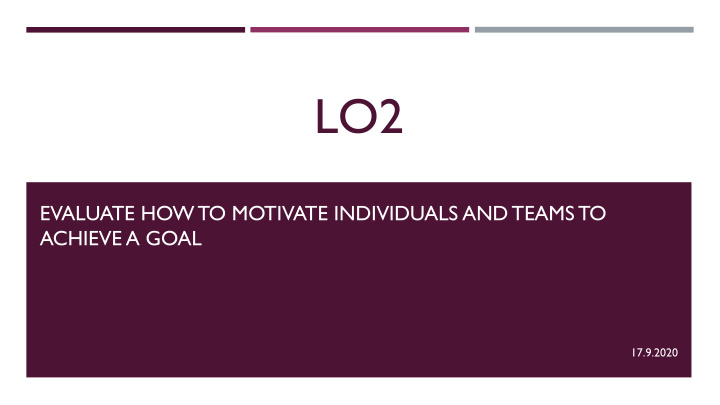



LO2 EVALUATE HOW TO MOTIVATE INDIVIDUALS AND TEAMS TO ACHIEVE A GOAL 17.9.2020
SESSION 5 EXTRINSIC AND INTRINSIC MOTIVATION CONTENT THEORIES OF MOTIVATION PROCESS THEORIES OF MOTIVATION
MOTIVATION Motivation is the process that accounts for an individual’s intensity, direction, and persistence of effort toward attaining a goal. Robins et al (2013)
MOTIVATION Motivation is a process that starts with a physiological and psychological deficiency or need that activates a behaviour or a drive that is aimed at a goal or incentive. Luthans (2002)
BASIC MOTIVATION PROCESS
MOTIVATION TYPES
EXAMPLES
MOTIVATIONAL THEORIES Content Process Theories Theories
CONTENT THEORIES Abraham Maslow’s Hierarchy of Needs Fredrick Herzberg’s T wo Factor Theory ERG theory by Clayton Alderfer
ABRAHAM MASLOW’S HIERARCHY OF NEEDS
LION KING STORY
ACTIVITY Questionnaire
CRITICISMS ON THE THEORY The theory assumes that all people experience these needs in the same order, failing to recognize cultural and individual differences. In collectivist societies, for example, social needs may be considered more important than physiological needs. Maslow’s description of self -actualization and how self-actualized people felt and behaved, was based on writing and talking to selectively chosen people rather than rigorous sampling. Maslow restricted the number of self-actualized people in his theory. At one time, he wrote that less than two percent of the total population is made of self-actualizes.
ERG THEORY BY CLAYTON ALDERFER
Existence needs Needs for physical well-being Relatedness needs Need for satisfactory relationships with others Growth needs Development of human potential and the desire for personal growth and increased competence.
FREDRICK HERZBERG’S TWO FACTOR THEORY
Recommend
More recommend